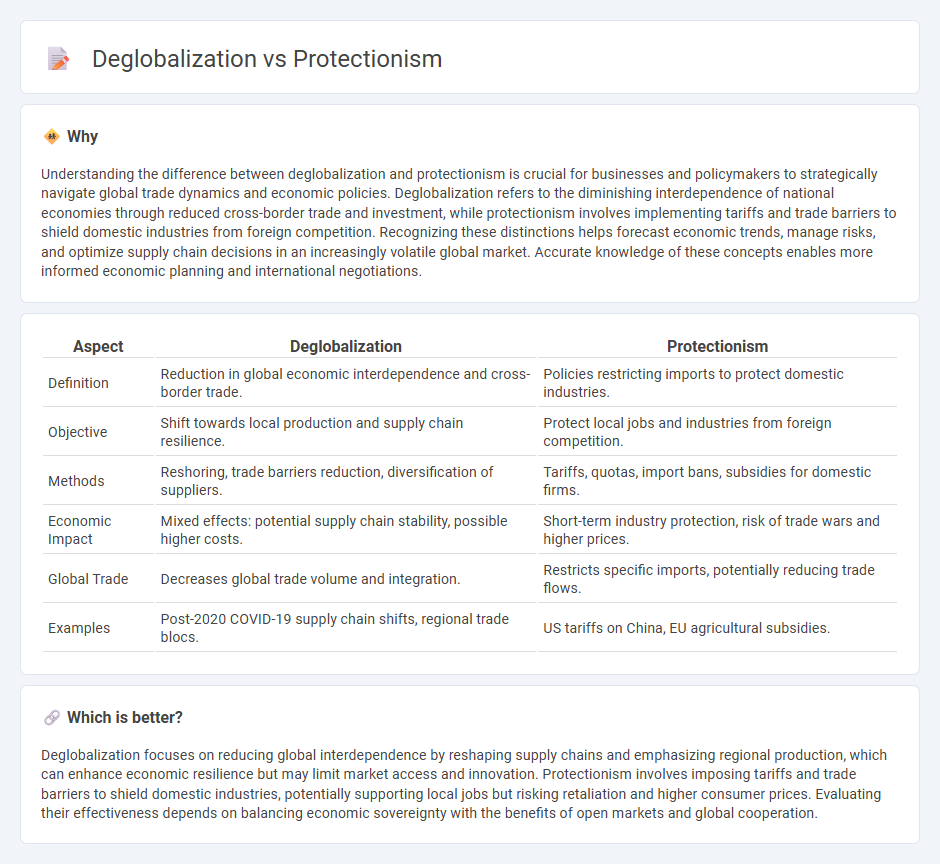
Deglobalization and protectionism represent contrasting economic approaches that influence trade policies and global market integration. Deglobalization involves reducing dependence on international trade to prioritize domestic industries, while protectionism enforces tariffs and trade barriers to shield local businesses from foreign competition. Explore the dynamics of these strategies and their impacts on the global economy to gain deeper insights.
Why it is important
Understanding the difference between deglobalization and protectionism is crucial for businesses and policymakers to strategically navigate global trade dynamics and economic policies. Deglobalization refers to the diminishing interdependence of national economies through reduced cross-border trade and investment, while protectionism involves implementing tariffs and trade barriers to shield domestic industries from foreign competition. Recognizing these distinctions helps forecast economic trends, manage risks, and optimize supply chain decisions in an increasingly volatile global market. Accurate knowledge of these concepts enables more informed economic planning and international negotiations.
Comparison Table
| Aspect | Deglobalization | Protectionism |
|---|---|---|
| Definition | Reduction in global economic interdependence and cross-border trade. | Policies restricting imports to protect domestic industries. |
| Objective | Shift towards local production and supply chain resilience. | Protect local jobs and industries from foreign competition. |
| Methods | Reshoring, trade barriers reduction, diversification of suppliers. | Tariffs, quotas, import bans, subsidies for domestic firms. |
| Economic Impact | Mixed effects: potential supply chain stability, possible higher costs. | Short-term industry protection, risk of trade wars and higher prices. |
| Global Trade | Decreases global trade volume and integration. | Restricts specific imports, potentially reducing trade flows. |
| Examples | Post-2020 COVID-19 supply chain shifts, regional trade blocs. | US tariffs on China, EU agricultural subsidies. |
Which is better?
Deglobalization focuses on reducing global interdependence by reshaping supply chains and emphasizing regional production, which can enhance economic resilience but may limit market access and innovation. Protectionism involves imposing tariffs and trade barriers to shield domestic industries, potentially supporting local jobs but risking retaliation and higher consumer prices. Evaluating their effectiveness depends on balancing economic sovereignty with the benefits of open markets and global cooperation.
Connection
Deglobalization and protectionism are closely linked as both emphasize reducing international trade and investment to protect domestic industries. Deglobalization involves scaling back global economic integration while protectionism enforces tariffs, import quotas, and regulatory barriers to shield local markets. These strategies collectively disrupt supply chains, increase production costs, and reshape global economic dynamics.
Key Terms
Tariffs
Tariffs serve as a primary tool in protectionism, imposing taxes on imported goods to shield domestic industries from foreign competition. Deglobalization often intensifies tariff policies as nations prioritize self-sufficiency and reduce reliance on international trade networks. Explore in-depth how tariff strategies shape the complex dynamics between protectionism and deglobalization.
Trade barriers
Trade barriers are central to both protectionism and deglobalization, with protectionism implementing tariffs, quotas, and import restrictions to shield domestic industries from foreign competition. Deglobalization intensifies these barriers by reducing global supply chain interdependencies and promoting local self-sufficiency, often leading to more widespread and systemic trade restrictions. Explore the nuances of trade barriers within protectionism and deglobalization to understand their impact on global markets.
Supply chain localization
Protectionism emphasizes imposing tariffs and trade barriers to protect domestic industries, often leading to supply chain localization to reduce dependency on foreign suppliers. Deglobalization involves a broader retreat from global economic integration, encouraging companies to shorten supply chains and prioritize local sourcing for resilience. Explore the differences in how these strategies impact global supply networks and economic stability.
Source and External Links
Protectionism - Definition, Types, Advantages and Disadvantages - Protectionism is a trade policy that protects domestic producers by imposing tariffs, quotas, or subsidies to limit foreign competition and boost domestic production.
Protectionism - Wikipedia - Protectionism involves restricting imports through tariffs, quotas, anti-dumping laws, subsidies, and administrative barriers to shield domestic industries from foreign competition.
Protectionism | Macroeconomics - Lumen Learning - Protectionism mainly uses tariffs, import quotas, and non-tariff barriers to make imported goods more expensive or restricted, encouraging consumers to buy domestic alternatives.
 dowidth.com
dowidth.com